Journal of Tourism & Hospitality
Open Access
ISSN: 2167-0269
+44 1300 500008
ISSN: 2167-0269
+44 1300 500008
Research Article - (2019)Volume 8, Issue 5
Tourism resources is one of the rudimentary components of travel and tourism industry. The sustainability of tourism development of a certain nation or region is determined by the availability and protection of tourism resources. With this regard, Jimma town and its nearby area as other part of Ethiopia blessed with diversify potential cultural, historical and natural tourism resources. Nevertheless, systematic and organized study as well as identification and documentation of potential tourism resources has not been done so far in Ethiopia in general and in Jimma town and its locality in particular. Therefore, this study is conducted to identify, systematic document and assess the management practice of potential tourism resources in Jimma town and its vicinity. To grasp this objective both quantitative and qualitative data collection methods has been used. In this study, significant data was collected from both secondary and primary sources. Primary data was collected through interviews, focus group discussion and direct observation. In the data analysis process both qualitative and quantitative research method has been employed. The finding of this study shows that Jimma town and its locality possesses a plethora of potential tourism resources. Concurring with the issues of conservation tourism resources of the study area is not well-conserved and preserved and affected as a result of natural and human factors. Therefore, the researcher strongly recommended that systematic intervention and immediate conservation work is needed to save the potential tourism resources of the study area from further damage and for sustainable tourism development.
Tourism resources; Documentation; Management practice; Jimma town
Tourist attraction/site is one of the basic components of the tourism industry. The flow of tourists/visitors to a particular country is determined by the number and degree of desirability of tourist attractions or sites. By its nature Tourist attraction place can be Cultural, Historical, natural and Archeological site. Having several tourist attractions resources/site is not only enough for the development of tourism industry in one country but also conservation and preservation of potential tourist attraction is very significant issues. Conserved and preserved potential tourist attraction site can have a vital role for sustainable tourism development [1,2].
Ethiopia is one of the African countries blessed with numerous natural, historical and archaeological tourists’ sites/attractions. For instance Ethiopia had ten UNESCO recorded heritage, its diversified topography that ranges from the lowest point on earth in the Danakil desert at Dallol depression to the highest peak at Ras Dashen; recognition as birthplace of the mother of all mankind, Lucy/Dinknesh/as source of the World’s longest and mighty river, Nile River; it’s fascinating nature and mild climate with thirteen months of sunshine, diversified culture with outstanding & district historic heritages makes Ethiopia one of the potential tourist destinations in east Africa [3-5].
Of the major tourist potential areas of Ethiopia, Jimma town and its locality is an area which is blessed with various attractions-natural, cultural and historical. For instance, Jimma town was a historic place in which the five Gibe Oromo state was formed. It is also the home of Jimma museum and Abba Jifar palace. Jimma town and its vicinity is gifted with many natural tourism resources, in spite of these facts, scientific and organized study as well as identification and documentation of potential tourist’s attraction site has not been done in Jimma town and its nearby area so far. Consequently, the main objective of this paper is to conduct a preliminary survey study so as to identify, document and show the potential tourist attraction sites in Jimma town and its vicinity and also to look at its management practices for the sustainable tourism development. The assessment of tourism resources of a particular area or region is very important in tourism development [6,7]. Scientific and organized study of tourist site give rise to identification and systematic documentation of tourism resources. This directly resulted tourist destination development, conservation & preservation of tourism resources and finally lead to sustainable tourism development (Figure 1).
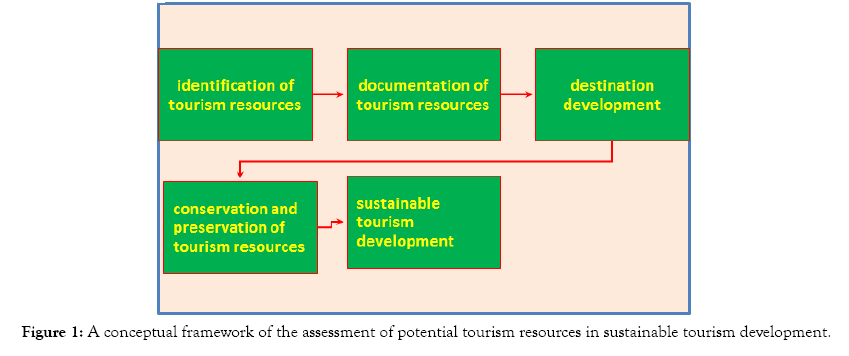
Figure 1: A conceptual framework of the assessment of potential tourism resources in sustainable tourism development.
This study has both general and specific objectives and presented as follows.
General objective
The general objective of this study is to identify, systematic document potential tourism resources and its management practices for sustainable tourism development in Jimma town and its locality, southwestern Ethiopia.
Specific objectives
• To carry out systematic Survey and documentation of potential tourism resources of Jimma town and its nearby area.
• To examine and enlighten the present status of tourism resources in the study area.
• To identify and examine the practice of preventive and interventive of potential tourism resources in the study area.
• To recommend the subsequent solution in protecting and preserving the remarkable tourism resources of the study area.
This study has great importance in introducing and promoting the potential tourism resources of the study area to the general public, researchers, and governmental and nongovernmental organizations. This study will show how and why the potential tourism resources destroyed particularly in the study area. Moreover, it will provide valuable information about the present conservation status of the tourism resources in Jimma town and its locality. In general, this study will help to create awareness on the current conservation practice of tourism resources of the study area among all the stakeholders like the ministry of culture and tourism, ARCCH, the regional tourism bureau, zonal and woreda level culture and tourism office. In addition, this study will also help to inspire many scholars for further investigation, particularly on the issues related to tourism resources. Academically, this study will contribute to the limited literature particularly on issues of tourism.
Definition and concept of tourism
It is obvious that, the term Tourism is defined in different ways by various individual scholar/group of intellectual at different times. Therefore, the United Nations World Tourism Organization (UNWTO) made great efforts to produce a common glossary of terms for tourism. Accordingly, UNWTO defines the term tourism as follows:
Tourism is a social, cultural and economic phenomenon which entails the movement of people to countries or people outside their usual environment for personal or business/professional purposes [8].
From the definition provided by the United Nations World Tourism Organization, we can say that tourism is the movement of people for numerous purposes either business or pleasure. As noted by the considerable growth of the tourism activity clearly marks tourism as one of the most outstanding economic and social phenomena of the past century [9]. Internationally, as an export category, tourism ranks fourth after fuels, chemicals and automotive products.
No doubt, for many developing countries tourism is one of the main sources of foreign exchange income and the number one export category, creating much needed employment and opportunities for development [10]. It is obvious that Ethiopia is one of the developing countries in Africa and the socio-economic contribution of tourism sector is too huge. According to Ethiopia ministry of culture and tourism report the country has earned 1,792,964,160 US dollars from international tourism and the country also received 88 thousand tourists per month [11]. Figure 2 Shows the International tourists’ arrivals in Ethiopia.
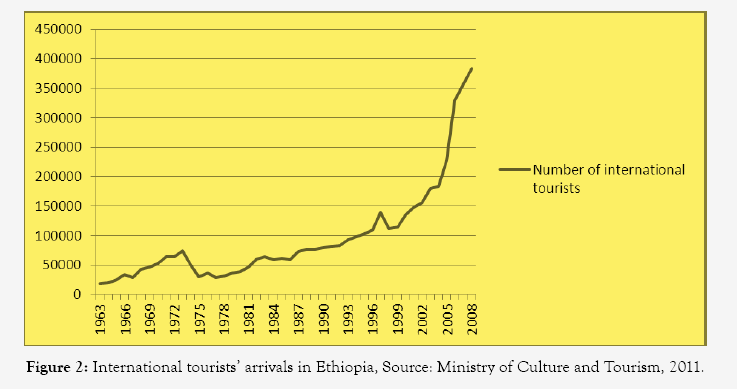
Figure 2: International tourists’ arrivals in Ethiopia, Source: Ministry of Culture and Tourism, 2011.
Overview of Ethiopia’s tourism industry
Seeing tourism as one of the economic sectors came into exist in Ethiopia very lately. As noted by Seyoum Merga. It was around the year 1960, that the potential of tourism sketched the consideration of the imperial government authorities [12]. For instance, the first tourism office was established in the year of 1962. Though, a hindrance in international tourism demand had been seen throughout the military regime. After 1974 for two decades Ethiopia tourism industry was sorrow from numerous adverse effects such as prolonged civil war, recurrent drought and restrictions on entry and free movement of tourists [13]. Nevertheless, the Ethiopia tourism sector is still at its infant phase, it has been rising since 2001.
Current challenges to be tackled Ethiopia’s tourism sector Ethiopia’s possession of varied attractions regarded as an opportunity for the Ethiopia tourism sector. However, currently, a number of major challenges also challenging the tourism sector of Ethiopia. Many scholars stated five basic factors regarding the current threats facing tourism sector of Ethiopia. Firstly, heritages of the country have not been adequately protected, developed and used as a tourist attraction. Secondly, there is a serious shortage in number and type of tourist facilities. Thirdly, there is a shortage of trained manpower that is crucial to the development of the sector. Fourthly, weak mutual support and coordination among tourism stakeholders. And finally, Ethiopia’s image on the international scene is widely associated with drought, famine and war.
To achieve the aim and objectives of the study, the researcher used both qualitative and quantitative data collection methods. Different data collecting tools under qualitative methods such as interviews, focus group discussion and filed work have been employed. Under quantitative, measurement of the dimension of the heritage site and measurement of GPS coordinates of the potential tourist site has been made by the researcher.
This study is conducted through the systematic collection and analysis of primary and secondary data. As a result, the data sources for this study was both primary and secondary data sources. For instance, the researcher used different written secondary sources such as books, journals, articles, senior essays, theses, and dissertations, to cross check and corroborate the information that the researcher obtains from informants. Significant primary data was collected from local people, concerned government body and tourists through interview, questioners, direct personal observation, field survey and focus group discussion.
Focus group discussion was also one of the methods that the researcher has been used for this study as a means of primary data collection techniques. The researcher conducted five focus group discussions with a member of ten participants for each discussion and the Participants for discussion has been selected purposefully based on age, gender and knowledge. In this study the researcher has been conducted reconnaissance survey in order to identify the location of potential tourist site, to look at the present conservation manner and the threatening factor of potential tourism resources in the study area. During the field survey the following activities has been done by the researcher.
• Interview was conducted with key informants and then the researcher take note
• The photograph of potential tourism resources which existed at study area has been taken by the researcher
• The existing potential tourist site in the study area has been identified, recorded and documented by the researcher
Design of the study
This study aims to identify, systematic document and assess the management practice of potential tourism resources in Jimma town and its nearby area. To achieve this objective, mixed research approach both qualitative and quantitative has been used. In this study, Mixed approach is chosen due to the data was collected through questionnaires, interviews, focus group discussion, direct observation and field survey. Meanwhile, the researcher tried to assess the management practices and document the tourism resources of the study area and pursues to describe it, as a result, a descriptive research design was used (Figure 3).
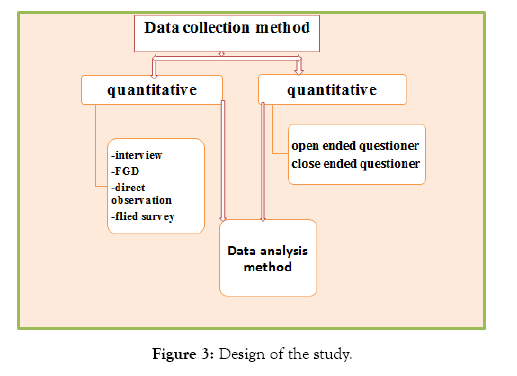
Figure 3: Design of the study.
Sampling technique and size
Sample is a technique or procedure that the researcher would adopt in selecting items for the sample. Size of the sample is the number of items to be selected from the population [14]. In this study both purposive and simple random sampling methods has been used. Purposive sampling indicates whom, where and how one does his/ her research [15]. Accordingly, the study area (Jimma town and its locality) was selected purposively based on the assumptions that the area has unstudied and unidentified potential tourism resources. The key informants for interview was also selected by using purposive sampling methods.
Data analysis methods
In this study, both qualitative (descriptive) and quantitative (statistical) approach has been used as data analysis method. The data that the researcher was collected by the above-mentioned techniques have been examined, checked and cross- checked for its credibility. Accordingly, data that was collected through interview filed survey and direct observation has been analyzed qualitatively. The data that the researcher has been collected through questionnaires and measurement was analyzed quantitatively.
Description of the study area
The area identified for this research, Jimma town and its vicinity found in western Oromia region of Ethiopia and are potential areas for the aforementioned research kinds as the areas are rich in both cultural and natural as well as unstudied and unidentified potential tourism resources. Jimma Zone is one of the zones of Oromia Regional State which is located in south western parts of Ethiopia. Jimma zone is divided into seventeen districts each with its own administrative capital. Jimma town is the capital of Jimma zone. Jimma Zone is bounded on the south by Southern Nations, Nationalities and Peoples Region (Kaffa zone), on the west and northwest by Illubabor Zone, on the northeast by West Shoa zone and in the East by Omo Zone of Southern Nation Nationalities and Peoples Region (see map 1) (Figure 4).
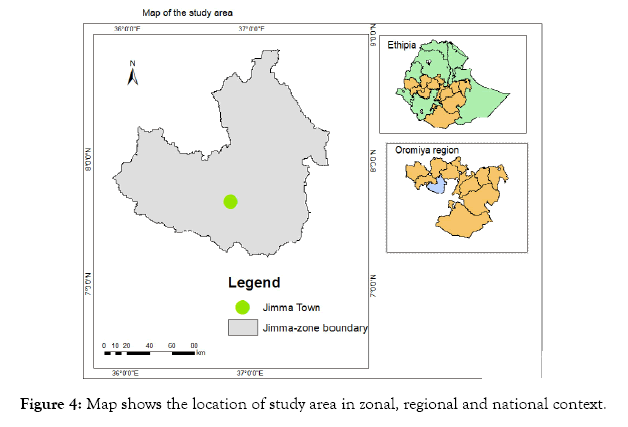
Figure 4: Map shows the location of study area in zonal, regional and national context.
This study shows that in Jimma town and its nearby area there are several potential tourist attraction sites. The identified tourist attraction sites of the study area are classified into two categorize. These are natural and cultural potential tourist attraction sites. The types and potential tourism resources of Jimma town and its nearby area is clearly presented in the below chart (Figure 5). In this study several potential cultural tourism resources of the study area have been identified. Hence, Aba jifar palace, Jimma museum, Oromo material culture and Jimma town public space were the major potential cultural tourism resources of Jimma town that was identified and documented by the researcher in this study. Besides, the aforementioned cultural tourism resources Jimma town and its locality blessed with natural potential tourism resources like saka water fall, unique landscape and Jiren mountain.
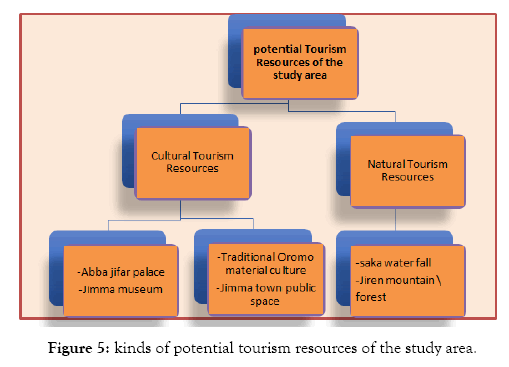
Figure 5: Kinds of potential tourism resources of the study area.
Potential cultural tourism resources of Jimma town and its locality
In this study, the researcher was firstly identified, documented and describe all the different potential tourism resources found in the Jimma town and its nearby area. For the sake of identification and documentation of tourism resources of the study area field survey and personal observation has been made by the researcher which has two major phases. In the first phase of field trip the due attention was given for cultural potential tourism resources of the study area. During this phase the cultural and historical potential tourism resources of Jimma town and its vicinity was identified, systematically documented and its conservation practice has been assessed. Accordingly, the identified potential tourism resources of the study area are presented and described in the next paragraph.
Aba Jifar palace
Aba Jifar palace is one of the potential cultural tourism resources of Jimma town and its locality. According to written and oral information from local elder the palace of Aba jifar was assembled in the second half of the 18th century specifically in the year of 1840 by king of five Gibe Oromo state known as Aba jifar II. The nomenclature of the palace is also associated with the history of the king. Currently, the palace is named and called as masaraa (palace) Abba jifar by Oromo people in their language called Afaan-Oromoo.
The geographical setting in which the palace is located added especial beauty and attraction to Abajifar palace. For instance, the palace is surrounded by a chain of mountains and unique landscape and the current area of the palace has been selected as political center of king Abajifar due its inaccessibility and geographically strategic place. According to oral information from local elders Aba jifar palace was built by king Abba jifar II in the year 1840 on a site located at seven kilometer north of Jimma town and the site was selected for its commanding location, from which it was possible to monitor enemy movements. The palace of Aba jifar is the oldest, largest and surviving traditional wooden architecture in Jimma town and its locality. The palace built from wooden in a unique architectural style. In the compound of the palace still stand another four buildings: the public mosque, the mosque of Abba Jifar, residential palace of Abba Jifar. The palace of Aba Jifar still stands with colorful architectural beauty (Figure 6A).
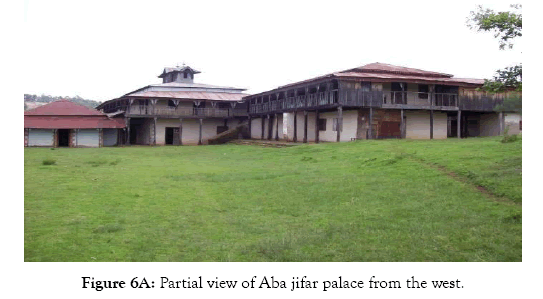
Figure 6A: Partial view of Aba jifar palace from the west.
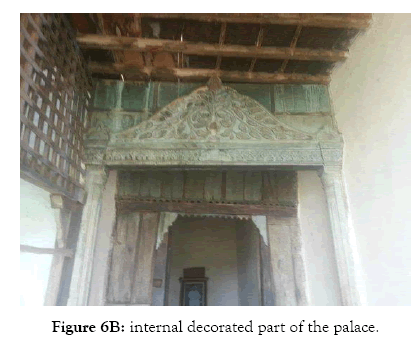
Figure 6B: Internal decorated part of the palace.
Oromo material culture
The other potential tourist attraction resources of Jimma town and its nearby area is the well-decorated Oromo material culture. One can find impressive Oromo material culture in the town which is made from wood and reflect the Oromo history, culture and architectural advancement (Figure 7A and 7B).
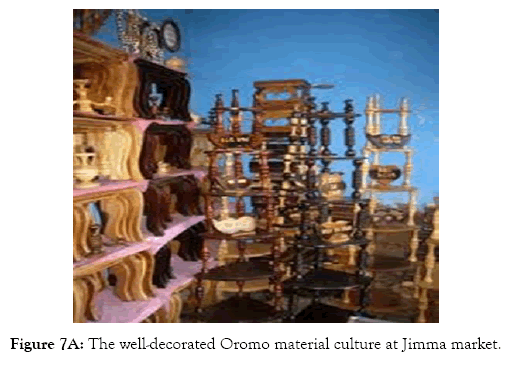
Figure 7A: The well-decorated Oromo material culture at Jimma market.
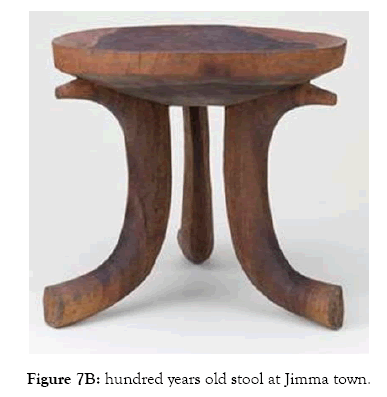
Figure 7B: Hundred years old stool at Jimma town.
Jimma town public space
Jimma town public space is one of the potential cultural tourism resources of the study area that was identified and documented by the researcher in this study. In the compound of Jimma town public space one can find the stand monument. The monument has rectangular shape it means that it has four faces and on each and every face of the monument historical, cultural and economic meaningful picture was painted. The picture painted on the east side of the monument clearly shows the history of the local Oromo people. For instance, on this side of the monument one can easily observe the picture of king Abba jifar of Jimma and his longlasted palace. On the north side of the monument one can see the picture of beautiful Oromo girl local known as Bililee. This part of monument reflects the culture, way of life and dressing style of local Oromo people. The west side of the monument found in Jimma town public space, shows the economic activities and economic history of local people. For instance, this side of the monument holds the picture like coffee trees and different agricultural tools and clearly indicate the kinds of economic activity and types plants that has been grow up in Jimma zone at all. To sum up, Jimma town public space is a potential cultural tourism resources of Jimma town due to it holds and reflects tradition and history of Oromo people definitely (Figure 8).
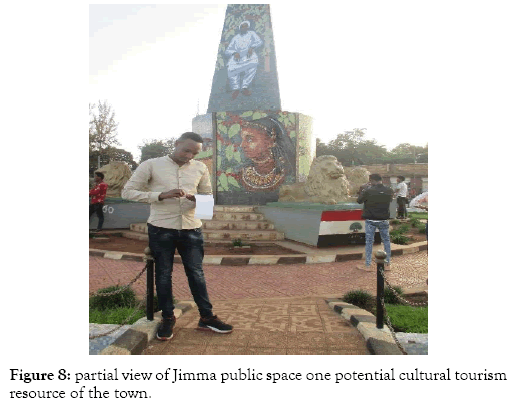
Figure 8: Partial view of Jimma public space one potential cultural tourism resource of the town.
Jimma museum
One of the potential cultural tourism resources of Jimma town is historic museum of Jimma. The museum is rich with hundreds of years old cultural, historical and archaeological materials. One can find different instruments, furniture, armaments, dresses, household items, and etc. from the time of Abba Jifar. Due to the richness of the museum with very old historical, cultural and archaeological valued collection, it considered as one potential cultural tourism resources of the study area (Figures 9A and 9B). Potential natural tourism resources of Jimma town and its locality
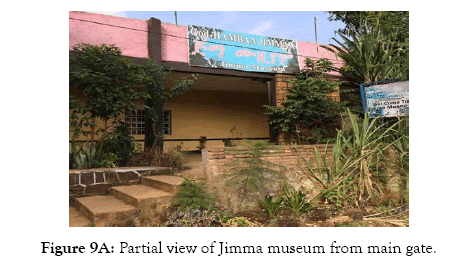
Figure 9A: Partial view of Jimma museum from main gate.
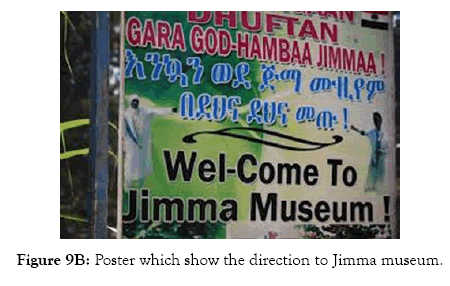
Figure 9B: Poster which show the direction to Jimma museum.
Saka water fall
One of the identified potential natural tourist attraction resources of Jimma town and its locality that was recorded and systematically documented in this study after long lasted survey is the saka water fall. The natural dense forest, unique landscape and human settlement that surround the site gave especial beauty and attraction to saka water fall. The very interesting part of saka water fall is that it is not season-based waterfall. In this study, with the aim of identification and systematic documentation of tourism resources of Jimma area field trip has been conducted and photography of the potential tourism resources has also taken with the help of camera. Due to high annual rainfall, the study area is rich in river, waterfalls and tropical forest vegetation which contributed a lot to the attraction of saka waterfall. According to the report from the National Metrology Agency (2011), Jimma Zone consistently receives good rains, ranging from 1,200-2,800 mm per annum. This condition resulted for the formation of many perennial rivers as a result of the topography, vegetation cover and rainfall pattern in the zone. In spite of saka water fall is a potential natural tourist attraction site of the study area the site has not been developed as a potential tourist destination. The whole area of the saka water fall is also not demarcated and protected as a tourist destination (Figure 10).
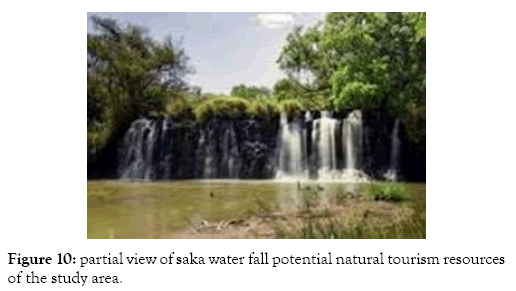
Figure 10: Partial view of saka water fall potential natural tourism resources of the study area.
This study is aimed at identifying, systematic document the potential tourist site and assessment of its management practice in Jimma town and its locality. To identify and record the potential tourism resources long lasted and scientific survey has been made by the researcher. The survey results show that Jimma town and its nearby area possesses a plethora of tourist attractions. One gears that makes Jimma town unique as far as concerning with tourism is the prevalence of diverse tourist attraction resources. As this preliminary study show that, we have different cultural and natural tourist attraction site in Jimma town and its nearby area. For instance, a hundred years old Oromo material culture and stool, palace, museum, public space and waterfalls were the major identified potential tourist attraction site of the study area. As noted by Tesfay Girma having diversified attraction/tourism resources is considered as a potential for the development of tourism in a given country or region [16]. With this regard, my study area blessed with different cultural, natural and historical potential tourism resources. Therefore, it is possible to conclude that Jimma town and its nearby area is a potential area for tourism development. Because of its richness with several and potential tourism resources.
Current conservation status of potential tourism resources in Jimma town and its locality
According to the ICOMOS charter for the protection and management of heritage resources, the assessment and documentation of potential heritage site is an essential method of conserving, preserving and promoting the tourism resources of a particular country. In spite of this fact, the potential tourism site of Jimma town and its locality was not assessed, documented and promoted to outside world so far. According to oral informants, as an important historical and cultural potential tourism resources of Ethiopia, Aba jifar palace have no paid appropriate conservation so far. Currently, the palace needs special conservation work and structural consolidation, but still no effort was made to conserve and protect this potential tourist attraction site of the study area from further damage.
The conservation of potential tourism resources requires a multi sectral, individual, governmental body and local community. The stakeholders, both the public and private sector, involved in tourism development in any area depending on their plan and policy that will achieve tourism development at any destination [17]. But, regarding the potential cultural tourism resources of Jimma town and its nearby area by the side of both regional and federal government nothing has been done to conserve, protect and promote this cultural heritage. According to oral information from local elder from the past up to the present day the palace of Aba jifar was conserved and protected only by the local community. This preservation and conservation action were done by none professionals and as a result no much more respect has been given to protect the originality of the palace.
As noted by Beeton S. Listing in the National Register helps preserve historic, cultural and natural tourism resources by providing formal recognition of a property’s historical, architectural, or archaeological significance based on national standards used in every state [18]. Nonetheless, in the study area, several natural and built-up cultural tourism resources like Jiren mountain and Jimma town public space not listed on the national register. Due to absences of registration of tourism resources on the national official list and due to lack of attention from the concerned government body the potential tourism resources of the study area has been exposed to human distraction.
As stated by Juliana P an excellent way of conserving and preserving potential natural and cultural tourism resources of certain region or area is by integrating it to development [19]. In spite of Jimma town and its locality riches with different potential tourism resources, these resources are not integrated to development. Develop a resource management plan that includes preparing, protecting, and managing our cultural, historical and natural tourism resources are crucial issue in sustainable tourism development [20,21]. In the case of the study area nothing has been done to set up a resources management plan which help in conserving and preserving the potential tourism resources of Jimma town and its nearby area. The preparation of the tourism resources database is very significant in promoting, conserving, preserving and sustainable tourism development. Having Tourism planning and tourism resources database is critical in direction of destination development [22]. As far as concerning with the study area One of the main complaints of all the respondents was the lack of identification, documentation and database of tourism resources.
Attraction/tourism resources is the basic component of the tourism industry. Therefore, there is no tourism without attraction/ tourism resources. This study was also conducted so as to identify, document and assess the conservation practice of the rudimentary element of tourism industry what we can call tourism resources. This preliminary study has been able to identify and document the potential tourism resources of Jimma town and its vicinity at all. As this study show that all kinds of tourism resources are existed at the study area. As far as concerning with the issues of conservation all of the natural potential tourism resources are of the study area is not placed under legal protection known as ‘Protected Areas’ this lack of legal rules created serious problems in the protection and preservation of natural potential tourism resources in the study area. This study shows that the potential tourism resources of Jimma town and its nearby area has been exposed to both human and natural devastation. Beside this, absences of tourism resources database, lack of coordination among different stockholders, absences of national level tourism resources inventory and lack of integration of historical and cultural heritage into development were some of the basic factors resulted the destruction of potential tourism resources in Jimma town and its locality.
Based on the findings of this study the researcher recommends the following major points that are important for the better conservation and preservation of potential tourism resources as well as the development of tourism at the study area.
• Many potential cultural tourism resources found in the study area like Aba jifar palace was affected as a result of poor conservation work, therefore systematic intervention and immediate conservation work is needed.
• In order to protect the potential natural and cultural tourism resources of Jimma town and its locality from the current and future human and natural destruction awareness creation and promotional works should be needed and expected from regional and federal government of Ethiopia.
• Several potential tourism resources of the study area have no buffer zone and not developed as protected area that contains values, instructions and guidelines that directed the interface of the local community and potential tourism resources. Therefore, developing spatial demarcations and both protected area and national park is awaited from all responsible bodies.
• The researcher of this study strongly recommends the immediate preparation of management and development plan of the tourism resources of the study area by linking it with the regional and national development plan. The preparation has to involve all stakeholders and the participation of local communities. I believe that the management plan will set the road map and the means and the way forward to sustainable conservation of the potential tourism resources of Jimma town and its locality.
For the better conservation of potential tourism resources of the study area responsibility for the protection and preservation of tourism resources should be delivered to appropriate official bodies. There should be a coordinating or advice-giving body, composed of representatives of the authorities responsible for the conservation of tourism resources, Provincial, municipal or other forms of local government should also have services responsible for the preservation of tourism resources and services responsible for the safeguarding of potential tourism resources should be adequately staffed.
Citation: Aman A (2019) Identification and Documentation of Potential Tourism Resources: It's Management Practice in Focus in Jimma Town and its Vicinity, Southwestern Ethiopia. J Tourism Hospit 8:418. doi: 10.35248/2167-0269.19.8.418
Received: 15-Oct-2019 Accepted: 27-Nov-2019 Published: 04-Dec-2019
Copyright: © 2019 Aman A. This is an open-access article distributed under the terms of the Creative Commons Attribution License, which permits unrestricted use, distribution, and reproduction in any medium, provided the original author and source are credited.